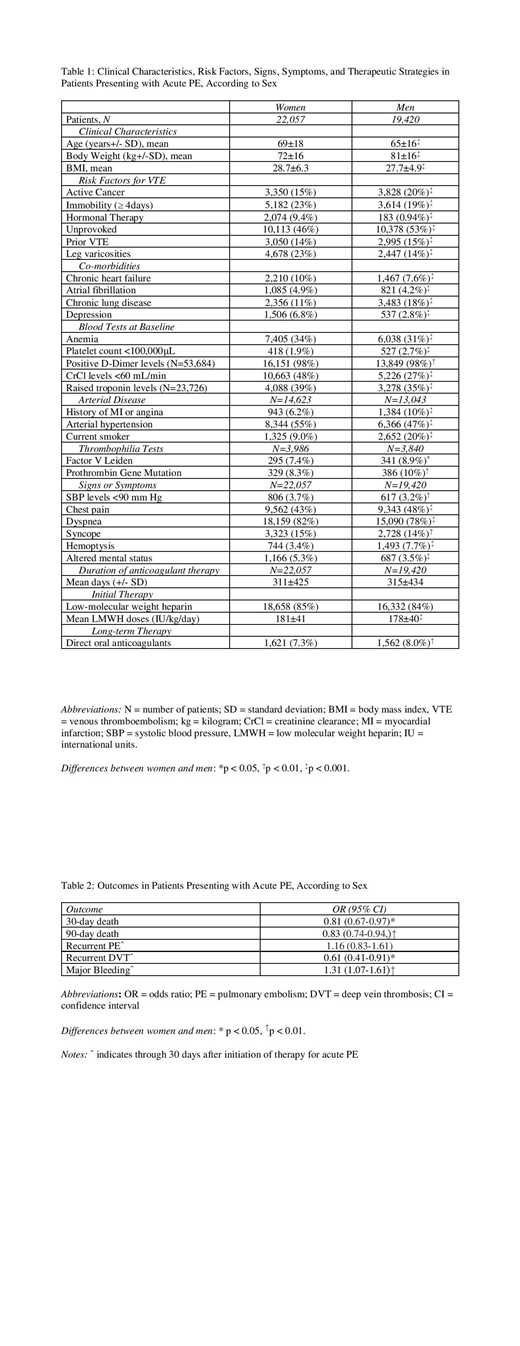Background
Pulmonary embolism (PE) is a major cause of morbidity and mortality in both the United States and worldwide. There is a paucity of contemporary clinical registry data regarding sex differences in the clinical presentation, treatment and outcomes of patients with acute PE.
Methods
Patients with PE from the RIETE (Registro Informatizado Enfermedad Trombo Embólica), a multicenter international prospective registry of patients with venous thromboembolism, were included. Patient characteristics between groups were compared using t-tests for continuous variables and chi-square tests for categorical variables. Multivariable logistic regression adjusting for baseline characteristics, clinical presentation and therapies was used to compare outcomes between both sexes. Outcomes included all-cause mortality, recurrent venous thromboembolism (VTE), and major bleeding through 30 days after initiation of PE treatment as well as all-cause mortality through 90 days.
Results
From January 2001 through June 2019, 41,477 patients with an acute PE were enrolled, of whom 22,057 (53%) were women. Women were older (mean age +/- standard deviation: 69 +/- 18 years versus 65 +/- 16 years), had higher body mass index (BMI) and were less likely to have cancer than men (Table 1). Women were also less likely to have prior VTE, chronic lung disease, history of MI or angina or an unprovoked PE but more likely to have recent immobilization, chronic heart failure, arterial hypertension, leg varicosities and depression. Women smoked less and fewer women tested positive for an inherited thrombophilia compared to men.
Initial presentation: Women presented more frequently with hypotension, tachycardia, dyspnea, syncope and altered mental status than men but women reported less frequently hemoptysis, cough or chest pain. The location of PE was similar between the sexes. Similarly, there was no difference in the initial medical treatment such as unfractionated heparin (UFH) between men and women. However, more men underwent embolectomy and had inferior vena cava filters (IVCF) placed. During the course of anticoagulation (mean duration: 311 days for women and 315 days for men), women received a higher mean dose of low molecular weight heparin (181 [+/-41] International Units (IU)/kilogram (kg)/day versus 178 [+/-40] IU/kg/day, p <0.001) compared to men. For the long-term therapy, women were less likely to receive a direct oral anticoagulant (DOAC).
Follow up: Women were less likely to die at 30-days (OR 0.81; 95% CI 0.67-0.97, p <0.05) and 90-days, (OR 0.83; 95% CI 0.74-0.94, p <0.01) and less likely to have recurrent DVT (OR 0.61; 95% CI 0.41-0.91, p <0.05), but more likely to suffer from major bleeding (OR 1.31; 95% CI 1.07-1.61, p <0.01) compared with men. There was no difference in the rates of recurrent PE (OR 1.16; 95% CI 0.83-1.61; Table 2).
Conclusion
In this international multicenter registry including >40,000 patients with an acute PE, we found that despite presenting with more signs and symptoms of severe PE, women were more likely to be alive at 30 and 90 days and had fewer DVT recurrences but more major bleeds than men.
Rosovsky:Dova Pharmaceuticals: Consultancy; Bristol-Myers Squibb: Research Funding; Janssen Pharmaceuticals: Consultancy, Research Funding.
Author notes
Asterisk with author names denotes non-ASH members.


This feature is available to Subscribers Only
Sign In or Create an Account Close Modal